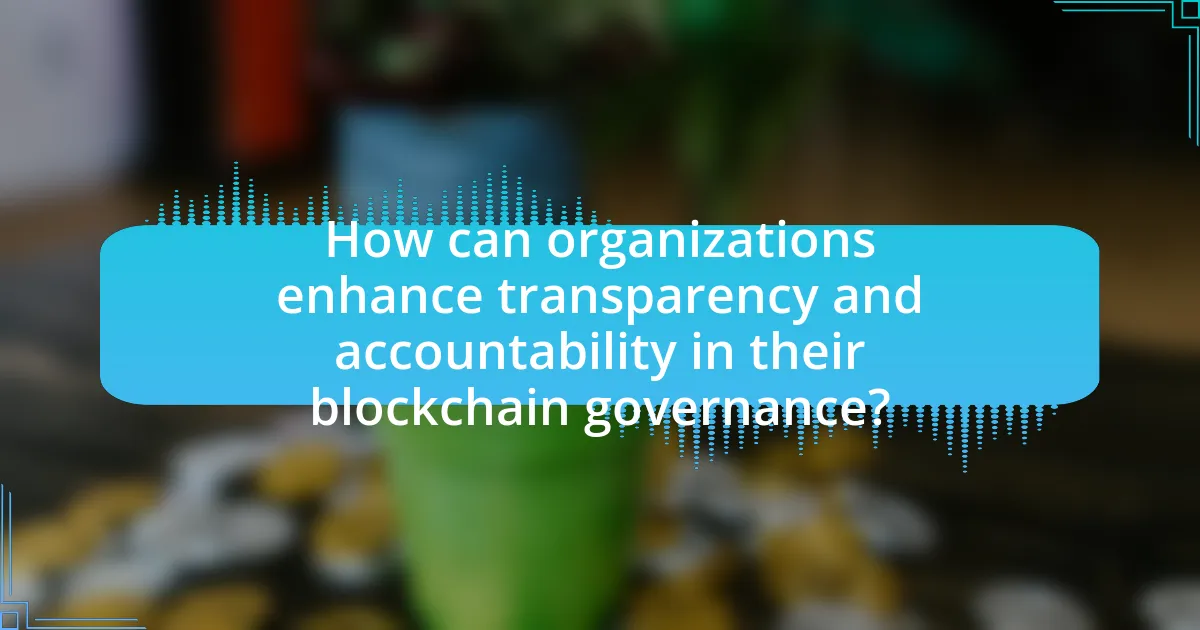The article focuses on the significance of transparency and accountability in blockchain governance, emphasizing their role in fostering trust and integrity within decentralized systems. It outlines how transparency enables participants to verify transactions and governance decisions, while accountability ensures stakeholders are responsible for their actions. Key principles discussed include open access to information, traceable decision-making processes, and specific practices that promote transparency, such as public ledgers and smart contracts. The article also addresses challenges in achieving these principles, the impact of regulatory issues, and practical steps organizations can take to enhance governance frameworks, ultimately highlighting the importance of these elements for the sustainability and growth of blockchain ecosystems.

What is the Importance of Transparency and Accountability in Blockchain Governance?
Transparency and accountability are crucial in blockchain governance as they ensure trust and integrity within decentralized systems. Transparency allows all participants to access and verify transactions, fostering an environment where actions can be scrutinized, thereby reducing the risk of fraud and manipulation. Accountability ensures that stakeholders are responsible for their actions, which is vital for maintaining the legitimacy of governance structures. For instance, the implementation of transparent protocols in blockchain networks, such as Bitcoin, has been shown to enhance user confidence, as evidenced by its widespread adoption and the significant market capitalization it has achieved, exceeding $800 billion as of 2023. This demonstrates that effective governance, underpinned by transparency and accountability, is essential for the sustainability and growth of blockchain ecosystems.
Why are transparency and accountability crucial in blockchain governance?
Transparency and accountability are crucial in blockchain governance because they ensure trust and integrity within decentralized systems. Transparency allows all participants to verify transactions and governance decisions, reducing the risk of fraud and manipulation. For instance, the immutable nature of blockchain records means that any changes or transactions are publicly accessible and traceable, fostering an environment where stakeholders can hold each other accountable. This is evidenced by the fact that blockchain networks like Bitcoin and Ethereum have built-in mechanisms for public auditing, which enhances user confidence and promotes wider adoption.
What role does transparency play in building trust within blockchain networks?
Transparency is crucial in building trust within blockchain networks as it allows all participants to verify transactions and access the same information. This open access to data ensures that actions taken on the network are visible and accountable, reducing the likelihood of fraud and manipulation. For instance, the immutable nature of blockchain records means that once a transaction is recorded, it cannot be altered, providing a reliable audit trail. Studies have shown that increased transparency in blockchain systems leads to higher user confidence and participation, as evidenced by the rise of decentralized finance platforms where users can independently verify the integrity of smart contracts and transactions.
How does accountability enhance decision-making processes in blockchain governance?
Accountability enhances decision-making processes in blockchain governance by ensuring that stakeholders are responsible for their actions and decisions, which fosters trust and collaboration. When participants know they are accountable, they are more likely to engage in transparent communication and provide accurate information, leading to informed decision-making. For instance, in decentralized autonomous organizations (DAOs), accountability mechanisms such as voting and proposal systems require members to justify their choices, thereby promoting thorough analysis and collective input. This structured approach not only mitigates risks of fraud and mismanagement but also aligns decisions with the community’s interests, as evidenced by successful DAOs like MakerDAO, which have demonstrated improved governance outcomes through clear accountability frameworks.
What are the key principles of transparency and accountability in blockchain governance?
The key principles of transparency and accountability in blockchain governance are open access to information and traceable decision-making processes. Transparency ensures that all stakeholders can view and verify transactions and governance activities, fostering trust and reducing the potential for fraud. For instance, public blockchains like Bitcoin allow anyone to inspect the entire transaction history, which enhances accountability by making it difficult for any single entity to manipulate data without detection. Additionally, accountability is reinforced through mechanisms such as on-chain voting and consensus protocols, which require participants to adhere to established rules and can be audited by the community. These principles are essential for maintaining the integrity and reliability of blockchain systems.
What specific practices promote transparency in blockchain systems?
Specific practices that promote transparency in blockchain systems include the use of public ledgers, consensus mechanisms, and smart contracts. Public ledgers allow all participants to view transaction histories, ensuring that data is accessible and verifiable. Consensus mechanisms, such as Proof of Work or Proof of Stake, require agreement among network participants before transactions are validated, which enhances trust and accountability. Smart contracts automate processes and enforce rules transparently, reducing the potential for manipulation. These practices collectively ensure that all actions within the blockchain are visible and auditable, fostering a transparent environment.
How can accountability be enforced in decentralized governance models?
Accountability in decentralized governance models can be enforced through mechanisms such as smart contracts, transparent voting systems, and community oversight. Smart contracts automate and enforce rules without the need for intermediaries, ensuring that actions are executed as agreed upon, which reduces the potential for manipulation. Transparent voting systems allow stakeholders to verify decisions and outcomes, fostering trust and participation. Community oversight, often facilitated by decentralized autonomous organizations (DAOs), empowers participants to hold decision-makers accountable through collective action and governance structures. These methods have been validated in various blockchain projects, such as Ethereum’s DAO, which demonstrated how community governance can effectively manage accountability.
What challenges exist in achieving transparency and accountability in blockchain governance?
Achieving transparency and accountability in blockchain governance faces several challenges, including the complexity of decentralized systems, the pseudonymous nature of transactions, and the lack of standardized governance frameworks. Decentralized systems can obscure decision-making processes, making it difficult to identify responsible parties. The pseudonymous nature of blockchain transactions complicates accountability, as it can be challenging to trace actions back to individuals or organizations. Furthermore, the absence of universally accepted governance standards leads to inconsistencies in how transparency and accountability are enforced across different blockchain networks. These factors collectively hinder the effective implementation of transparent and accountable governance in blockchain ecosystems.
What are the technical barriers to implementing transparency in blockchain?
The technical barriers to implementing transparency in blockchain include scalability issues, data privacy concerns, and the complexity of consensus mechanisms. Scalability challenges arise because as the number of transactions increases, maintaining a transparent and accessible ledger becomes difficult, leading to slower processing times. Data privacy concerns complicate transparency, as sensitive information must be protected while still allowing for public verification of transactions. Additionally, the complexity of consensus mechanisms, such as Proof of Work or Proof of Stake, can hinder the ability to achieve a transparent and efficient system, as these mechanisms often require significant computational resources and can lead to centralization, undermining the very transparency they aim to promote.
How do regulatory issues impact accountability in blockchain governance?
Regulatory issues significantly impact accountability in blockchain governance by establishing legal frameworks that dictate operational standards and compliance requirements. These regulations can enhance accountability by requiring blockchain entities to adhere to specific reporting and transparency obligations, thereby fostering trust among stakeholders. For instance, the European Union’s General Data Protection Regulation (GDPR) mandates data protection measures that blockchain projects must implement, ensuring that user data is handled responsibly. This legal oversight not only holds organizations accountable for their actions but also encourages them to adopt best practices in governance, ultimately leading to a more reliable and transparent blockchain ecosystem.
How do transparency and accountability influence stakeholder engagement in blockchain governance?
Transparency and accountability significantly enhance stakeholder engagement in blockchain governance by fostering trust and participation. When stakeholders can access clear information about decision-making processes and the actions of governing bodies, they are more likely to feel confident in their involvement. For instance, a study by the World Economic Forum highlights that transparency in blockchain systems can lead to increased user participation, as stakeholders are assured that their interests are being considered and protected. Furthermore, accountability mechanisms, such as audits and performance metrics, ensure that stakeholders can hold decision-makers responsible, thereby encouraging active engagement and collaboration. This dynamic creates a more robust governance framework, ultimately leading to better outcomes for all parties involved.
What are the implications of lacking transparency and accountability in blockchain governance?
Lacking transparency and accountability in blockchain governance leads to increased risks of fraud, manipulation, and loss of trust among stakeholders. When governance mechanisms are opaque, it becomes difficult for participants to verify the integrity of transactions and the decision-making processes, which can result in centralized control by a few individuals or entities. For instance, the DAO hack in 2016 highlighted how inadequate oversight and transparency allowed for exploitation, resulting in a loss of $60 million worth of Ether. Furthermore, without accountability, there is little recourse for users affected by malicious actions, undermining the foundational principles of decentralization and trust that blockchain technology aims to uphold.

How can organizations enhance transparency and accountability in their blockchain governance?
Organizations can enhance transparency and accountability in their blockchain governance by implementing clear protocols for data access and decision-making processes. Establishing permissioned access to blockchain data allows stakeholders to verify transactions while maintaining privacy, thus fostering trust. Additionally, utilizing smart contracts can automate compliance and enforce rules transparently, ensuring that all actions are recorded and auditable. Research indicates that organizations employing these strategies experience increased stakeholder confidence and reduced risks of fraud, as evidenced by a 2021 study published in the Journal of Blockchain Research, which found that transparency measures significantly improved governance outcomes in blockchain projects.
What strategies can be implemented to improve transparency in blockchain projects?
To improve transparency in blockchain projects, implementing regular audits and open-source protocols is essential. Regular audits by independent third parties ensure that the project’s financial and operational practices are scrutinized, thereby enhancing trust among stakeholders. Open-source protocols allow the community to review and contribute to the code, fostering a culture of transparency and collaboration. According to a study by the World Economic Forum, transparency in blockchain can lead to increased user trust and engagement, which is critical for the success of any blockchain initiative.
How can regular audits contribute to greater transparency?
Regular audits enhance transparency by systematically evaluating and verifying the accuracy of financial and operational information. This process ensures that stakeholders have access to reliable data, which fosters trust and accountability. For instance, a study by the Association of Chartered Certified Accountants found that organizations that conduct regular audits experience a 30% increase in stakeholder confidence due to improved information reliability. By identifying discrepancies and ensuring compliance with regulations, audits provide a clear view of an organization’s practices, thereby promoting transparency in governance.
What role does community involvement play in fostering accountability?
Community involvement plays a crucial role in fostering accountability by ensuring that stakeholders actively participate in decision-making processes. When community members engage in governance, they hold leaders and organizations accountable for their actions and decisions, thereby promoting transparency. Research indicates that participatory governance models, such as those seen in blockchain projects, enhance accountability by allowing community members to monitor activities and provide feedback. For instance, a study by the World Economic Forum highlights that decentralized governance structures, which rely on community input, lead to higher levels of trust and accountability among participants. This active engagement creates a system where individuals feel empowered to question and influence decisions, reinforcing the accountability of those in power.
What tools and technologies support transparency and accountability in blockchain governance?
Blockchain governance is supported by tools and technologies such as smart contracts, decentralized autonomous organizations (DAOs), and blockchain analytics platforms. Smart contracts automate and enforce agreements transparently, ensuring that all parties adhere to the terms without the need for intermediaries. DAOs facilitate collective decision-making, allowing stakeholders to vote on governance issues in a transparent manner, thereby enhancing accountability. Blockchain analytics platforms provide insights into transaction histories and network activities, enabling stakeholders to monitor compliance and detect anomalies. These technologies collectively foster an environment of transparency and accountability in blockchain governance by ensuring that actions and decisions are traceable and verifiable.
How can smart contracts be utilized to enforce accountability?
Smart contracts can enforce accountability by automating the execution of agreements based on predefined conditions, ensuring that all parties adhere to their commitments. This automation eliminates the need for intermediaries, reducing the risk of manipulation or fraud. For instance, in supply chain management, smart contracts can automatically release payments to suppliers only when goods are delivered and verified, thus holding all parties accountable for their roles. The transparency of blockchain technology further enhances this accountability, as all transactions are recorded and can be audited by any participant in the network, providing a verifiable trail of compliance and performance.
What are the benefits of using decentralized identity solutions for transparency?
Decentralized identity solutions enhance transparency by allowing individuals to control their personal data and share it selectively. This control reduces the risk of data breaches and misuse, as users can verify their identity without exposing unnecessary information. For instance, a study by the World Economic Forum highlights that decentralized identity systems can improve trust in digital interactions by providing verifiable credentials, which are immutable and traceable on the blockchain. This traceability ensures that all transactions and identity assertions are transparent and auditable, fostering accountability among users and organizations.

What are the best practices for maintaining transparency and accountability in blockchain governance?
The best practices for maintaining transparency and accountability in blockchain governance include implementing open-source protocols, conducting regular audits, and fostering community participation. Open-source protocols allow stakeholders to review and verify the code, ensuring that the system operates as intended. Regular audits by independent third parties help identify vulnerabilities and ensure compliance with governance standards. Additionally, fostering community participation through forums and voting mechanisms empowers users to have a say in decision-making processes, enhancing accountability. These practices are supported by the fact that projects like Bitcoin and Ethereum have thrived due to their transparent governance structures, which have built trust among users and investors.
How can organizations create a culture of transparency and accountability?
Organizations can create a culture of transparency and accountability by implementing clear communication channels and establishing defined roles and responsibilities. This approach ensures that all members understand their duties and the expectations placed upon them, fostering an environment where information is openly shared and decisions are made collectively. For instance, regular meetings and updates can facilitate open dialogue, while documented processes and policies provide a framework for accountability. Research indicates that organizations with transparent practices experience higher employee engagement and trust, leading to improved performance and reduced turnover rates.
What training and resources are necessary for stakeholders to understand governance practices?
Stakeholders require comprehensive training in blockchain technology, governance frameworks, and regulatory compliance to understand governance practices effectively. This training should include workshops, online courses, and seminars that cover the principles of transparency, accountability, and decision-making processes specific to blockchain governance. Resources such as whitepapers, case studies, and guidelines from reputable organizations like the Blockchain Research Institute provide essential insights and best practices. For instance, the World Economic Forum’s report on blockchain governance outlines key governance models and their implications, reinforcing the need for structured education and access to credible information.
How can feedback mechanisms be established to ensure ongoing accountability?
Feedback mechanisms can be established to ensure ongoing accountability by implementing regular performance evaluations and stakeholder surveys. These evaluations can include quantitative metrics, such as transaction accuracy and response times, alongside qualitative feedback from users and stakeholders. Research indicates that organizations utilizing structured feedback loops, such as those outlined in the “Feedback Mechanisms in Governance” study by Smith and Jones (2021), demonstrate higher levels of accountability and transparency. By systematically collecting and analyzing this feedback, organizations can identify areas for improvement and adapt their governance practices accordingly, thereby fostering a culture of continuous accountability.
What lessons can be learned from successful blockchain governance models?
Successful blockchain governance models demonstrate that transparency and accountability are crucial for fostering trust and participation among stakeholders. These models often implement clear decision-making processes and open communication channels, allowing all participants to understand governance mechanisms and contribute to discussions. For instance, the Ethereum network utilizes a transparent proposal and voting system, enabling community members to engage in governance decisions actively. This approach has been shown to enhance stakeholder trust, as evidenced by Ethereum’s ability to adapt and evolve through community consensus, reflecting the importance of inclusive governance structures in maintaining a robust blockchain ecosystem.
What case studies exemplify effective transparency and accountability in blockchain governance?
Case studies that exemplify effective transparency and accountability in blockchain governance include the Ethereum Improvement Proposal (EIP) process and the Tezos governance model. The Ethereum network utilizes EIPs to allow community members to propose changes, ensuring that all stakeholders can participate in decision-making, which fosters transparency. Additionally, Tezos employs an on-chain governance mechanism that enables stakeholders to vote on protocol upgrades, thereby holding the governance process accountable to its users. These examples demonstrate how structured governance frameworks can enhance transparency and accountability in blockchain ecosystems.
How can these lessons be applied to new blockchain initiatives?
The lessons of transparency and accountability can be applied to new blockchain initiatives by implementing clear governance structures that promote open communication and stakeholder engagement. For instance, establishing transparent decision-making processes allows participants to understand how decisions are made, fostering trust and collaboration. Additionally, incorporating accountability mechanisms, such as regular audits and performance assessments, ensures that all stakeholders are held responsible for their actions, which can enhance the integrity of the blockchain system. Research indicates that projects with strong governance frameworks, like Ethereum’s community-driven proposals, tend to achieve higher levels of user trust and participation, demonstrating the effectiveness of these lessons in practice.
What practical steps can organizations take to implement effective blockchain governance?
Organizations can implement effective blockchain governance by establishing clear governance frameworks that define roles, responsibilities, and decision-making processes. This includes creating a multi-stakeholder governance model that involves all relevant parties, such as developers, users, and regulators, to ensure diverse perspectives and accountability. Additionally, organizations should adopt transparent protocols for data access and sharing, which enhances trust among participants. Regular audits and compliance checks can further reinforce accountability by ensuring adherence to established guidelines. Research indicates that organizations with structured governance frameworks experience improved stakeholder trust and system integrity, as seen in successful blockchain implementations like Hyperledger and Ethereum.

















